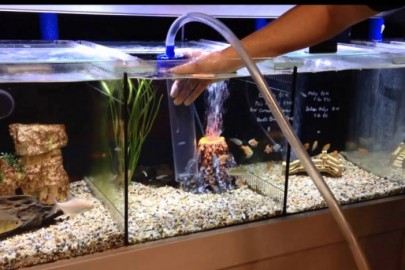Planted Aquariums Guide
Discus fish can be kept in aquariums with plants or without. An aquarium without plants may be easier to maintain but it lacks aesthetic value among other great benefits that come with planted aquariums. Planted aquariums are spectacular. This article is about plants for discus aquarium that can be planted inside a discus fish tank.
Advantages of planted aquariums
The first and most obvious advantage of aquarium plants in a discus fish tank is the aesthetic value displayed by the unmatched beauty of the two. Discus fish are known to be beautiful and they move around slowly and plants on the other are natural greens and reds. This is scenic.
Secondly, aquarium plants act as chemical filters that are responsible for the removal of toxic substances from the water in the fish tank. Bearing in mind the fact that discuses are very sensitive to presence of toxic substances, these plants would be very helpful. The plants would also get rid of several diseases such as “hole-in-the-head” and the like.
Thirdly, aquarium plants are a perfect hiding place for the usually shy discus fish. Whenever discuses are bothered by whatever is outside the tank, they can easily find refuge within the plants. Unlike other improvised tank decorations like rocks or driftwood, the aquarium plants don’t hurt the discus. All these will keep the discus healthy.
Finally, aquarium plants with broad leaves are a perfect natural breeding ground for discus fish as they spawn on the plants. This is in comparison to the other options like an inverted cone which are not natural.
Examples of Aquarium Plants
An important aspect to consider when it comes to choice of aquarium plants is its maintenance. Plants with the lowest maintenance are preferable. Maintenance means disturbance to the discus fish and hence the lesser the number of times it is carried out the better. Maintenance also has to do with rate of growth of the plants, which should be as slow as possible. Below are examples of some of the most common aquarium plants.
1. Echinodorus family
This is one of the most common aquarium plants that can be planted in a discus fish tank. The main reason could be that the Echinodorus family is natives to the Amazon basin which happens to be the same for discus fish. They usually come in different shapes and sizes and hence one can choose either of them depending on his/her preferences.
Some of the members of this family are Echinodorus bleheri (commonly known as Amazon Sword), E. amazonicus, E. major, E. cordifolius, E. tenellus which looks like grass and are simple to grow and several others.
2. Anubias family
These are larger in size and they are from Africa. They play a great role as background as well as accent plants despite the fact that they aren’t indigenous to the discus biotope. Most people blend it with Echinodorus because of their color which is dark green and their different shape of their leaves. They are good for spawning of the discus fish.
Examples of plants in this family are Anubias barteri which have horizontal leaves, nana which is usually smaller and A. coffeeafolia which has unique leaves which are deeply incised. The other members of the family are A. afzelli and A. congensis. These two are larger and hence can only fit in tall fish tanks.
3. Crytocoryne family
These are tall and thin aquarium plants and they are dark in color. Some of the members of this family are C. wendtii and C. blassi. C. wendtii have a wide range of varieties and so one can have several choices as per their leaf shapes.
Other families of aquarium plants include Ammania family, Bacopa family, Java Fern, Microsorum pteropus, Micranthemum family and Hydrocotyle family, among others.
Aquarium plants to avoid
Not all plants are recommended for an aquarium meant for discus fish. These are the plants that do not do well in warm water as they are adapted to cooler water. Some of these plants are Samolus parviflorus, Amoracia aquatic and Bacopa caroliniana.
Apart from suitability to temperature of the water in the fish tank, there are other plants that are not recommended as they are hard to maintain due to their fast growth. These include Hygrophila family, Ludwigia family, Rotala family and Large Vallisneria family (unless they are controlled).
More information on Aquarium Plants can be found HERE





